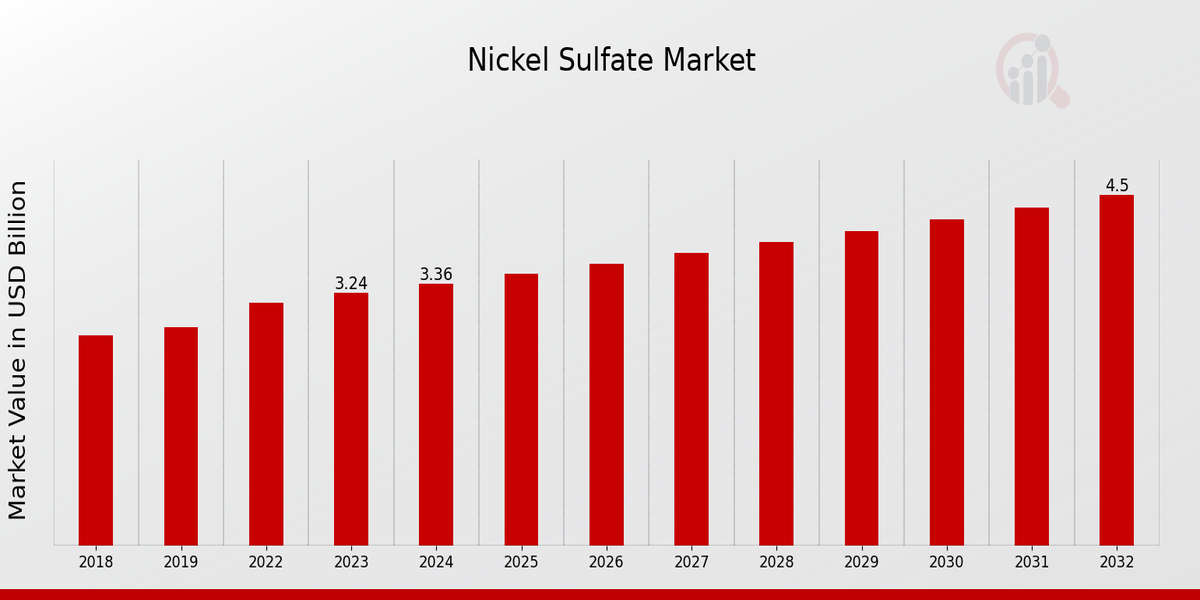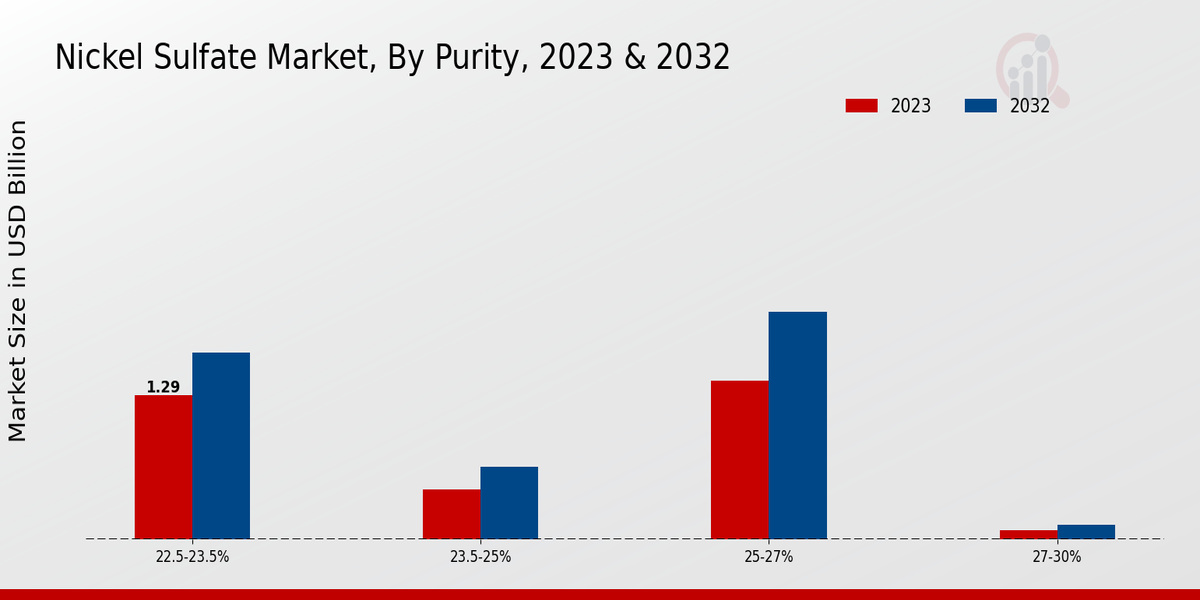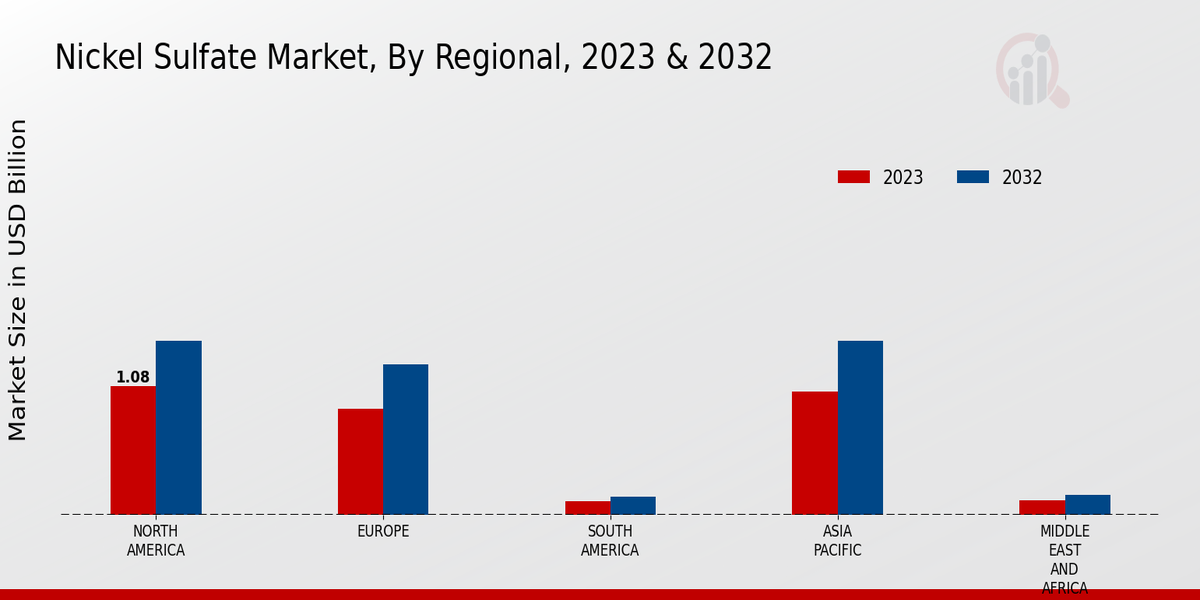Nickel Sulfate Market Overview
As per MRFR analysis, the Nickel Sulfate Market Size was estimated at 3.48 (USD Billion) in 2024. The Nickel Sulfate Market Industry is expected to grow from 3.61 (USD Billion) in 2025 to 5.02 (USD Billion) by 2034. The Nickel Sulfate Market CAGR (growth rate) is expected to be around 3.7% during the forecast period (2025 - 2034).
Key Nickel Sulfate Market Trends Highlighted
Key market drivers for nickel sulfate include its increasing applications in a variety of industries, particularly electroplating, where it is utilized to enhance metal surfaces to improve their strength, durability, and corrosion resistance. Additionally, the growing demand for lithium-ion batteries, used in electric vehicles and consumer electronics, is propelling the market growth of nickel sulfate, as it is a crucial component in the production of cathodes for these batteries.Opportunities for exploration in the nickel sulfate market center around technological advancements in battery technologies, leading to a potential expansion of its applications in energy storage and transportation sectors. Furthermore, the push towards sustainable solutions and the adoption of clean energy technologies, including electric vehicles, present opportunities for the nickel sulfate market to capture new revenue streams.Recent trends in the nickel sulfate market indicate a growing emphasis on sustainability and environmental consciousness. Manufacturers are exploring innovative and eco-friendly techniques to reduce their environmental impact, including the adoption of efficient production processes and the utilization of recycled materials. This shift towards sustainable practices aligns with the increasing demand for greener solutions across industries, making sustainability a key aspect of market growth.

Source: Primary Research, Secondary Research, MRFR Database and Analyst Review
Nickel Sulfate Market Drivers
Growing Demand for Nickel-Based Batteries
The increasing popularity of electric vehicles and energy storage systems is fueling the demand for nickel-based batteries. Nickel sulfate is a key raw material used in the production of these batteries, as it provides high energy density and long cycle life. As the adoption of electric vehicles accelerates, the demand for nickel sulfate is expected to surge, driving the growth of the Nickel Sulfate Market Industry. Furthermore, the growing demand for renewable energy sources, such as solar and wind power, is also contributing to the increased demand for nickel-based batteries, as they provide backup power during periods of intermittent generation.
Stringent Environmental Regulations
Governments worldwide are implementing stricter environmental regulations to reduce emissions and protect the environment. Nickel sulfate is a byproduct of the nickel mining and refining process, and its production can generate hazardous waste. As a result, companies are investing in cleaner production technologies and recycling initiatives to minimize their environmental impact. These regulations are expected to drive the adoption of more sustainable nickel sulfate production methods, which could increase the cost of production but also create opportunities for companies that can meet the new standards.
Expansion of the Stainless Steel Industry
Nickel sulfate is also used in the production of stainless steel, which is an alloy of iron, chromium, and nickel. The growing demand for stainless steel in various industries, such as construction, automotive, and chemical processing, is expected to drive the demand for nickel sulfate. The expansion of the stainless steel industry, particularly in emerging economies, is expected to contribute to the growth of the Nickel Sulfate Market Industry.
Nickel Sulfate Market Segment Insights
Nickel Sulfate Market Purity Insights
The purity segment of the Nickel Sulfate Market is expected to see substantial growth in the future, primarily due to the high demand from a wide range of end-use industries, such as batteries and electroplating. In terms of the different grades of purity, it is expected that 23.5-25% will occupy a significant market share. This particular grade is used in the electroplating industry for the purpose of producing nickel coatings on other types of metals to prevent wear and improve the appearance of the products. For up the purity scale, 25-27% of Nickel Sulfate’s demand is already growing for the production of batteries.In particular, the lithium-ion batteries used in electric automobiles as well as a wide range of consumer electronics, benefit from the substance's higher purity and superior performance. As for the highest degree of required purity, the substance measuring 27-30% is utilized in the production of nickel-cadmium batteries. These types of energy storage units are known for their particularly long operational cycles and excellent performance at elevated temperatures. This battery type is used in a wide range of industries, most notably in the military.Overall, the Nickel Sulfate Market’s purity segment is gradually creating more solid growth, as it is clear, based on the available information, that both nickel-based batteries and electroplating are becoming increasingly desirable for different industries. At the same time, key market players are expanding their production capacities and diversifying their product portfolios to address the growing demand for high-purity Nickel Sulfate.

Source: Primary Research, Secondary Research, MRFR Database and Analyst Review
Nickel Sulfate Market Form Insights
The Nickel Sulfate Market is segmented by Form into Hexahydrate Crystals, Anhydrous Powder, and Liquor. The Hexahydrate Crystals segment held the largest market share in 2023 and is expected to continue its dominance throughout the forecast period. The growth of the segment is due to the increasing demand for nickel sulfate hexahydrate in the electroplating industry. Nickel sulfate hexahydrate is used as an electrolyte in the process of electroplating, where it helps deposit a thin layer of nickel on various metal surfaces. The process of electroplating is likely to increase in demand over the upcoming years on account of the increased demand for corrosion-resistant and decorative coatings on products in industries like automotive, electronics, and building and construction.Hence, the Hexahydrate Crystals segment is expected to experience significant growth over the upcoming years.
Nickel Sulfate Market Application Insights
The Nickel Sulfate Market is segmented into Electroplating, Batteries, Chemicals, Catalysis, and Pigments applications. The Electroplating segment is the largest application, accounting for over 50% of the Nickel Sulfate Market revenue in 2023. The Batteries segment is expected to grow at the highest CAGR of 4.2% during the forecast period, driven by the increasing demand for electric vehicles and energy storage systems. The Chemicals segment is expected to witness steady growth due to the increasing demand for nickel sulfate in the production of fertilizers and other chemicals.The Catalysis segment is expected to grow at a moderate pace, driven by the increasing demand for nickel sulfate in the production of catalysts. The Pigments segment is expected to experience moderate growth due to the increasing demand for nickel sulfate in the production of pigments and dyes.
Nickel Sulfate Market End-User Industry Insights
The End-User Industry segment plays a crucial role in shaping the dynamics of the Nickel Sulfate Market. In 2023, the Automotive sector held a dominant share of the market, accounting for over 30% of the Nickel Sulfate Market revenue. The surging demand for electric vehicles and the subsequent increase in battery production have been key drivers of this segment's growth. The Electronics industry is projected to witness steady growth over the forecast period, owing to the increasing use of nickel sulfate in electronic components such as capacitors and batteries.The Aerospace industry is also expected to contribute significantly to the market growth, driven by the rising demand for nickel-based superalloys in aircraft manufacturing. The Construction and Chemical processing industries represent other notable end-user segments, utilizing nickel sulfate in applications such as electroplating, metal finishing, and chemical synthesis.
Nickel Sulfate Market Grade Insights
The Grade segment of the Nickel Sulfate Market is categorized into Technical Grade, Battery Grade, and Electronic Grade. Among these, the Battery Grade segment held the largest market share in 2023, accounting for around 60% of the Nickel Sulfate Market revenue. This dominance is attributed to the increasing demand for electric vehicles and energy storage systems, which utilize nickel-based batteries. The Technical Grade segment is projected to exhibit a steady growth rate during the forecast period, driven by its applications in electroplating, metal finishing, and chemical manufacturing.The Electronic Grade segment is expected to witness moderate growth due to its use in electronic components and semiconductors. Overall, the Grade segment of the Nickel Sulfate Market is poised for significant growth in the coming years, supported by the rising demand from various end-use industries.
Nickel Sulfate Market Regional Insights
Regionally, North America held the largest market share of 35% in 2023. The growth in this region is attributed to the increasing demand for nickel sulfate from the battery industry, particularly in the electric vehicle sector. Europe stood as the second-largest market, accounting for 28% of the revenue in 2023. The region's automotive industry is a major consumer of nickel sulfate, driving the market growth. The APAC region is projected to witness the fastest growth over the forecast period, with a CAGR of 4.2%. The growing electronics and battery industries in countries like China, Japan, and South Korea are fueling the demand for nickel sulfate in the region.South America and MEA are expected to contribute modest shares to the market, with CAGRs of 3.5% and 2.9%, respectively.

Source: Primary Research, Secondary Research, MRFR Database and Analyst Review
Nickel Sulfate Market Key Players And Competitive Insights
Major players in the Nickel Sulfate Market industry are continuously leveraging cutting-edge technologies and strategic collaborations to gain a competitive edge. Leading Nickel Sulfate Market players are focused on developing innovative products and solutions to cater to the evolving demands of end-users. The Nickel Sulfate Market development landscape is characterized by mergers, acquisitions, and collaborations as companies seek to expand their footprint and enhance their product portfolio. The competitive landscape is expected to remain dynamic in the coming years, with key players vying for market share through strategic initiatives and product innovation.BHP, a leading player in the Nickel Sulfate Market, is renowned for its extensive operations and robust production capabilities. The company's commitment to sustainability and responsible mining practices has earned it a strong reputation in the industry. BHP operates several nickel mines and processing facilities worldwide, allowing it to meet the growing demand for nickel sulfate in various end-use sectors. Its vertically integrated supply chain provides cost advantages and ensures consistent product quality.Glencore, a mining and commodities trading company, is another major competitor in the Nickel Sulfate Market. The company has a diversified portfolio of nickel assets, including mines, processing facilities, and trading operations. Glencore's strong logistics network and presence enable it to efficiently distribute nickel sulfate to customers worldwide. The company's focus on operational efficiency and cost optimization has contributed to its competitive position in the market.
Key Companies in the Nickel Sulfate Market Include
-
Jinchuan Group
-
LKAB
-
Eramet
-
Anglo American
-
BHP Billiton
-
Sumitomo Metal Mining
-
Vale
-
Sherritt International
-
Umicore
-
Glencore
-
Boliden
-
Norilsk Nickel
-
Outokumpu
-
Polymetal International
-
Nornickel
Nickel Sulfate Market Industry Developments
The Nickel Sulfate Market is projected to reach USD 4.5 billion by 2032, exhibiting a CAGR of 3.72% during the forecast period of 2024-2032. The growth is attributed to increasing demand from the electroplating industry, which utilizes nickel sulfate for surface treatment of metals. The construction sector is also expected to contribute to market growth, as nickel sulfate is used in the production of stainless steel. Furthermore, the rising popularity of electric vehicles is expected to drive demand for nickel sulfate, as nickel is a key component of lithium-ion batteries.Recent news developments in the Nickel Sulfate Market include the announcement by BHP Group, a leading mining company, of plans to invest $5.7 billion in the Nickel West project in Western Australia. This investment is expected to increase nickel sulfate production capacity by 50%, meeting the growing demand from the battery industry. Additionally, the Indonesian government has imposed a ban on nickel ore exports, which has led to a surge in nickel sulfate prices. This ban is expected to have a significant impact on the nickel sulfate market, as Indonesia is one of the largest producers of nickel ore.
Nickel Sulfate Market Segmentation Insights
| Report Attribute/Metric |
Details |
| Market Size 2024 |
3.48 (USD Billion) |
| Market Size 2025 |
3.61 (USD Billion) |
| Market Size 2034 |
5.02 (USD Billion) |
| Compound Annual Growth Rate (CAGR) |
3.7% (2025 - 2034) |
| Report Coverage |
Revenue Forecast, Competitive Landscape, Growth Factors, and Trends |
| Base Year |
2024 |
| Market Forecast Period |
2025 - 2034 |
| Historical Data |
2020 - 2024 |
| Market Forecast Units |
USD Billion |
| Key Companies Profiled |
Jinchuan Group, LKAB, Eramet, Anglo American, BHP Billiton, Sumitomo Metal Mining, Vale, Sherritt International, Umicore, Glencore, Boliden, Norilsk Nickel, Outokumpu, Polymetal International, Nornickel. |
| Segments Covered |
Purity, Form, Application, End-User Industry, Grade, Regional |
| Key Market Opportunities |
Growing demand for stainless steel batteries and electroplating Expansion into emerging markets Technological advancements Environmental regulations driving demand Increasing demand for nickel sulfate in cathode materials for EV batteries |
| Key Market Dynamics |
Growing demand for electric vehicles Lithium ion batteries and stainless-steel Increasing adoption of nickel-based batteries Government regulations promoting EV adoption Fluctuating raw material prices Technological advancements in nickel sulfate production |
| Countries Covered |
North America, Europe, APAC, South America, MEA |
Frequently Asked Questions (FAQ) :
The Nickel Sulfate Market is expected to reach a valuation of USD 5.02 billion by 2034, exhibiting a CAGR of 3.7% during the forecast period (2025-2034).
Asia-Pacific is anticipated to lead the Nickel Sulfate Market throughout the forecast period due to the region's robust growth in the automotive and electronics industries, which are major consumers of nickel sulfate.
Nickel Sulfate finds extensive applications in various industries, including electroplating, battery manufacturing, and chemical synthesis. In electroplating, it is used to coat metals with a thin layer of nickel for enhanced corrosion resistance and aesthetics. In battery manufacturing, it serves as a precursor for the production of nickel-based cathodes used in lithium-ion batteries.
Major players in the Nickel Sulfate Market include Jinchuan Group, Glencore, ERAMET, BHP Billiton, and Sumitomo Metal Mining. These companies hold significant market shares and influence the industry's competitive landscape through their production capacities, technological advancements, and distribution networks.
The increasing demand for nickel sulfate in the manufacturing of electric vehicle batteries is a primary growth driver for the market. Governments worldwide are promoting the adoption of electric vehicles to reduce carbon emissions, which is fueling the demand for nickel sulfate, a crucial component in battery production. Additionally, the growing use of nickel sulfate in electroplating and chemical synthesis further contributes to market growth.
Nickel mining and processing can pose environmental challenges, including the generation of hazardous waste and air pollution. Sustainable practices and technologies are being adopted to minimize these impacts and ensure responsible production. Furthermore, fluctuations in nickel prices and geopolitical uncertainties can affect the stability and profitability of the Nickel Sulfate Market.
The future of the Nickel Sulfate Market appears promising, driven by the increasing adoption of electric vehicles and the expanding electronics industry. As battery technology continues to advance and demand for nickel sulfate remains strong, the market is expected to witness steady growth in the coming years.
Technological advancements in battery manufacturing and electroplating techniques are driving innovation in the Nickel Sulfate Market. The development of high-performance nickel-based batteries for electric vehicles and the optimization of electroplating processes to improve efficiency and reduce environmental impact are notable trends shaping the market.
The Nickel Sulfate Market is segmented based on application, end-use industry, and region. Key application segments include electroplating, battery manufacturing, and chemical synthesis. Major end-use industries include automotive, electronics, and aerospace. Geographically, the market is segmented into Asia-Pacific, North America, Europe, South America, and the Middle East & Africa.
The price of Nickel Sulfate is influenced by several factors, including the supply and demand dynamics of the nickel market, production costs, transportation expenses, and geopolitical factors. Nickel mining and processing costs, as well as economic conditions and trade policies, can impact the overall pricing of Nickel Sulfate.

















